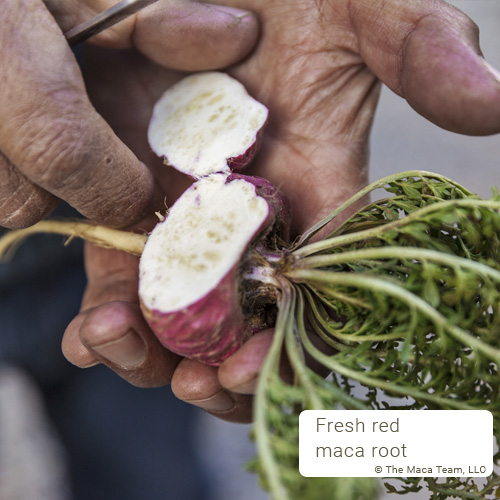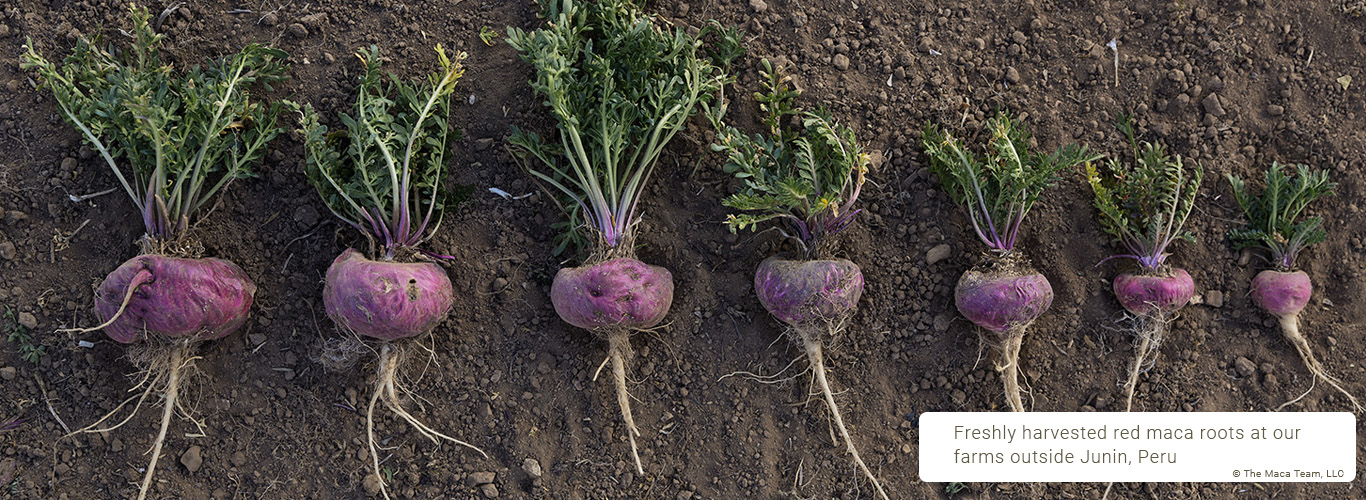Red Maca
Red Maca Additional Information
 If you visit a maca farm in the mountains of Peru during harvest time, you'll see that maca roots grow in a variety of colors. This is quite interesting because all maca roots come from the same seeds, grow in the same soils, and belong to the same species (lepidium meyenii a.k.a lepidium peruvianum). For 1,000s of years, this has not been an issue; all colors of maca were lumped together at harvest and then consumed as a mixture to boost energy and fertility. That changed in the late 1990s when researchers began to discover that the different colors of roots have slightly different nutritional profiles and potential benefits. Since then, maca has been separated into 3 main phenotypes: black, red and yellow. Even though we now make maca available in those 3 colors as well as in a traditional blend of all 3, red has certainly become a customer favorite over the years – and with good reason. Discover all of the documented benefits of red maca. (https://www.themacateam.com/red-maca-benefits)
If you visit a maca farm in the mountains of Peru during harvest time, you'll see that maca roots grow in a variety of colors. This is quite interesting because all maca roots come from the same seeds, grow in the same soils, and belong to the same species (lepidium meyenii a.k.a lepidium peruvianum). For 1,000s of years, this has not been an issue; all colors of maca were lumped together at harvest and then consumed as a mixture to boost energy and fertility. That changed in the late 1990s when researchers began to discover that the different colors of roots have slightly different nutritional profiles and potential benefits. Since then, maca has been separated into 3 main phenotypes: black, red and yellow. Even though we now make maca available in those 3 colors as well as in a traditional blend of all 3, red has certainly become a customer favorite over the years – and with good reason. Discover all of the documented benefits of red maca. (https://www.themacateam.com/red-maca-benefits)
Maca is a traditional food that grows under harsh conditions in the very high mountains of Peru (above 13,000 ft / 4,000 m). It is, in fact, the world’s highest growing vegetable crop. Maca responds well to extreme differences in temperatures, subpar soil conditions, high winds and intense sunlight. Because of where and how it grows, this plant has resisted intensive domestication. In the high Andes, it has never been “standardized” or genetically modified. For that reason, maca still demonstrates a healthy diversity of natural variations in size, and color. We have, in fact, seen a range of maca root color differences that is astounding. One of our maca farmers says he can identify over 30 different types. As for red maca, roots that fall under the red phenotype, range in color from light pink to dark maroon – some with lighter or darker spots and some with a solid color. When maca roots are harvested, farmers dig them out with a small pick and place them into burlap bags for transport. The roots are then transported to a central location where they are immediately separated by color: red, black and yellow and then dried. All of this is done by hand and supports 1,000s of farmers each year.
What makes red maca different?
Seen from the outside, it's the skin of course. Like black and yellow roots, the red color is limited to the skin. If you cut open any maca root, you'll see that the flesh inside is actually an off white, similar to a common radish. That's why you'll notice that maca powders only vary slightly in color, all of them being a light brown color. A black maca powder will only be slightly darker than a yellow one typically. And a red powder won't be completely red. Rather it will have a somewhat reddish hue or be a bit darker than the others.
But below the skin there is more to the story. All organically grown Peruvain maca powders share a nearly identical nutritional profile that is packed with vitamins and is a good source of fiber.
Powder from red maca roots has been shown, under analysis, to be higher in certain compounds that can work to support the body in antioxidant and antitumoral activity. It has also been shown among all maca colors to contain somewhat higher levels of other phytonutrients including alkaloids, tannins, saponis and sterols.
Another significant difference between red, black and yellow is the taste. Most people find the flavor of maca in general to be similar to a malty caramel flavor. Some people love it and some don't. In terms of maca from red roots, we've found it to be the most palatable. It has a gentler and milder flavor and is undoubtedly the sweetest of all colors. In fact, some of our customers even use it on their oatmeal instead of a standard sweetener!
Finally, red maca has been the subject of a number of clinical research trials over the past 20 years. This research suggests that red maca has some unique benefits when compared to black or yellow maca. Read more about red maca benefits.
Different kinds of red maca
There are actually several distinct ways to process red maca roots for consumption. Each way creates a different taste and nutrient profile.
Raw red maca comes from roots that are dried out in the sun for approximately one month. This preserves nutrients levels and also gets rid of the sharp taste associated with fresh maca roots.
Gelatinized red maca is pre-cooked during processing in order to remove most of the starch content of the roots. Some of the nutrients are lost in this process, but not a tremendous amount. Anyone with sensitive digestion should use this maca over raw.
Premium raw red maca is a newer type of maca that comes when fresh roots are dried in low temperature dehydrators instead of in the sun. The resulting maca products do have higher glucosinolate content, but are more pungent in taste.
Premium gelatinized red maca is also pre-cooked, but made from roots that are fresh processed as outlined above. Again this resulting products have higher levels of glucosinolates, but also tastes much stronger.
Here’s what to consider when buying red maca products
- Make sure your products are made from 100% organic red maca root powder, rather than just a mixture of various colors.
- Insist that the maca you purchase comes from Peru – particularly the Junin region as this area produces the best maca by far.
- Go for organic - maca can and is grown organically and traditionally without the use of pesticides and chemicals.
- Freshness is important – maca can be stored for several years, but that’s not ideal. Always try to buy maca from the most recent harvest and keep it in a sealed container once you do have it.
- Non-GMO - This is easy since Peru has banned all GMO (genetically modified organisms) from all of its agriculture until 2035.
How to successfully enjoy red maca products
Maca is a great addition to your diet. Here’s what we recommend for experiencing the most benefits from using it.
- Take your organic red maca root powder daily for at least 1 month as it can take that long to feel the health benefits.
- Take the right amount – about 1-3 teaspoons of powder, 2-8 capsules, or 2 droppersful of liquid extract.
- Try adding red maca powder to some recipes to mix things up - visit our collection of red maca recipes.

If you have any questions please let us know. We’re happy to help you find the right maca and get the most out of adding it to your life.
Enjoy the day!
![]()

